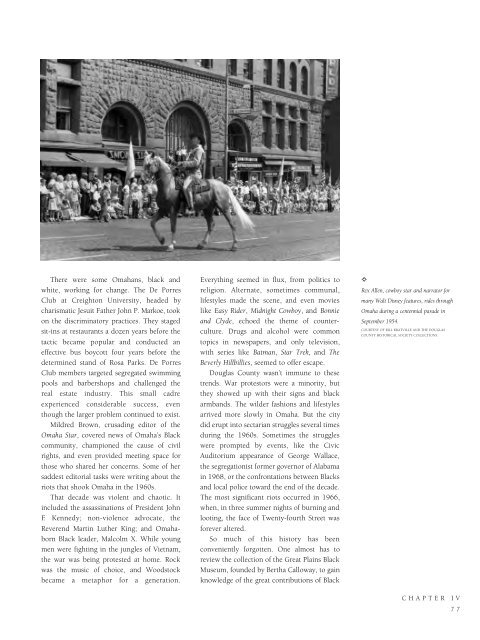Historic Omaha
An illustrated history of Omaha and the Douglas County area, paired with the histories of companies, families and organizations that make the region great.
An illustrated history of Omaha and the Douglas County area, paired with the histories of companies, families and organizations that make the region great.
You also want an ePaper? Increase the reach of your titles
YUMPU automatically turns print PDFs into web optimized ePapers that Google loves.
There were some <strong>Omaha</strong>ns, black and<br />
white, working for change. The De Porres<br />
Club at Creighton University, headed by<br />
charismatic Jesuit Father John P. Markoe, took<br />
on the discriminatory practices. They staged<br />
sit-ins at restaurants a dozen years before the<br />
tactic became popular and conducted an<br />
effective bus boycott four years before the<br />
determined stand of Rosa Parks. De Porres<br />
Club members targeted segregated swimming<br />
pools and barbershops and challenged the<br />
real estate industry. This small cadre<br />
experienced considerable success, even<br />
though the larger problem continued to exist.<br />
Mildred Brown, crusading editor of the<br />
<strong>Omaha</strong> Star, covered news of <strong>Omaha</strong>’s Black<br />
community, championed the cause of civil<br />
rights, and even provided meeting space for<br />
those who shared her concerns. Some of her<br />
saddest editorial tasks were writing about the<br />
riots that shook <strong>Omaha</strong> in the 1960s.<br />
That decade was violent and chaotic. It<br />
included the assassinations of President John<br />
F. Kennedy; non-violence advocate, the<br />
Reverend Martin Luther King; and <strong>Omaha</strong>born<br />
Black leader, Malcolm X. While young<br />
men were fighting in the jungles of Vietnam,<br />
the war was being protested at home. Rock<br />
was the music of choice, and Woodstock<br />
became a metaphor for a generation.<br />
Everything seemed in flux, from politics to<br />
religion. Alternate, sometimes communal,<br />
lifestyles made the scene, and even movies<br />
like Easy Rider, Midnight Cowboy, and Bonnie<br />
and Clyde, echoed the theme of counterculture.<br />
Drugs and alcohol were common<br />
topics in newspapers, and only television,<br />
with series like Batman, Star Trek, and The<br />
Beverly Hillbillies, seemed to offer escape.<br />
Douglas County wasn’t immune to these<br />
trends. War protestors were a minority, but<br />
they showed up with their signs and black<br />
armbands. The wilder fashions and lifestyles<br />
arrived more slowly in <strong>Omaha</strong>. But the city<br />
did erupt into sectarian struggles several times<br />
during the 1960s. Sometimes the struggles<br />
were prompted by events, like the Civic<br />
Auditorium appearance of George Wallace,<br />
the segregationist former governor of Alabama<br />
in 1968, or the confrontations between Blacks<br />
and local police toward the end of the decade.<br />
The most significant riots occurred in 1966,<br />
when, in three summer nights of burning and<br />
looting, the face of Twenty-fourth Street was<br />
forever altered.<br />
So much of this history has been<br />
conveniently forgotten. One almost has to<br />
review the collection of the Great Plains Black<br />
Museum, founded by Bertha Calloway, to gain<br />
knowledge of the great contributions of Black<br />
✧<br />
Rex Allen, cowboy star and narrator for<br />
many Walt Disney features, rides through<br />
<strong>Omaha</strong> during a centennial parade in<br />
September 1954.<br />
COURTESY OF BILL KRATVILLE AND THE DOUGLAS<br />
COUNTY HISTORICAL SOCIETY COLLECTIONS.<br />
CHAPTER IV<br />
77
















